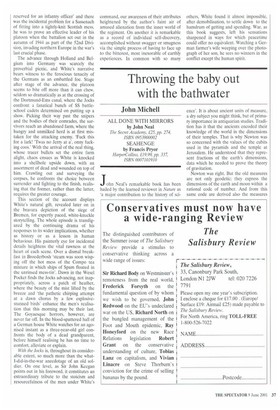Throwing the baby out with the bathwater
John Michell
ALL DONE WITH MIRRORS by John Neal The Secret Academy, .£25, pp. 274, ISBN 0953900002 SEAHENGE by Francis Pryor HaTerCollins, £19.99, pp. 337, ISBN 0007101910 John Neal's remarkable book has been hailed by the learned reviewer in Nature as a major contribution to the history of sci
ence'. It is about ancient units of measure, a dry' subject you might think, but of primary importance in antiquarian studies. Tradition has it that the ancients encoded their knowledge of the world in the dimensions of their temples. That is why Newton was so concerned with the values of the cubits used in the pyramids and the temple at Jerusalem. He understood that they represent fractions of the earth's dimensions, data which he needed to prove the theory of gravitation.
Newton was right. But the old measures are not only geodetic; they express the dimensions of the earth and moon within a rational code of number. And from this same code are derived also the measures and ratios of music, geometry, astronomy, chronology and physics. John Neal's discoveries give firm ground to the Pythagorean world-view that 'all is number'. There have been many systems of measure throughout the world, but all of them, including the units extrapolated from Mexican monuments, are related to the others by simple fractions, and together make up a single universal system. At the root of all the basic unit of reference is the ancient foot that we are now in the process of discarding. The best arguments against that process are in the findings of this book.
It is a large book, and with its elaboration of numbers, tables and diagrams it looks daunting. But it is plainly written, and compared with Hawking's Brief History of Time it is easy going. It is also to my mind far more relevant. The knowledge behind ancient science is eternal, unlike the theories of modern physics. For timid readers the author has sturdy advice: 'I recommend that those who have difficulties with numbers resolve them and read on until they do understand.' I recommend that too. It is worth the effort.
Francis Pryor is a professional archaeologist and his outlook on the past is completely different from Neal's. For over 30 years he has been excavating relics of domestic and ritual life, from the Stone Age onwards, trying to gain insight into the nature of prehistoric societies, their successive cults and practices and the influence of these upon the development of the landscape. Most of his diggings are at fenland sites in East Anglia, where there is nothing much to be seen on the surface and everything depends on scientific analysis of ancient objects and post-holes. This is done by Pryor's team of experts at Flag Fen near Peterborough where in 1982 he discovered an important Bronze Age sanctuary.
This book is a worthy work but there is not much drama in it. It was not until 1998, when his book was almost finished, that an exciting discovery provided Pryor with his lead theme and title. On a sandy beach in north Norfolk, exposed by the tides, appeared Seahenge-. It was a circle of wooden stumps surrounding a large oak trunk which had been thrust head-down into a pit, exposing its roots. Pryor and his team were called in. They identified the structure as a shrine (possibly for the `excarnation' of dead bodies), dated it to 2,000 BC and then set about removing the timbers for preservation at Flag Fen. This caused an uproar, mainly from the 'travelling community' — hippies, Druids, goddess people and the like. They interfered with Pryor's demolitions and upset him in front of television cameras. It was an unfortunate confrontation because Pryor does not believe in Druids, past or present. Nor does he believe in 'alternative archaeology', and his views on Stonehenge are highly non-mystical. It was, he suggests, like a government work scheme to revitalise a depressed region. He compares it
to Antony Gormley's gigantic 'Angel of the North' statue. From this I realised that his imagination works quite differently from mine. But in the end I quite enjoyed this rambling account of his minor antiquarian adventures.



































































 Previous page
Previous page